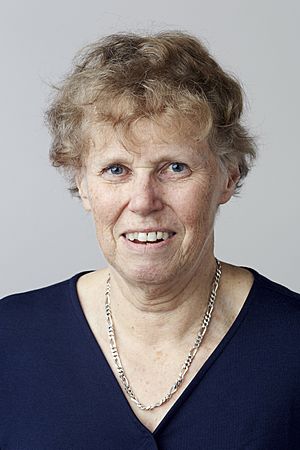Marian Dawkins facts for kids
Quick facts for kids
Marian Dawkins
|
|
|---|---|

Dawkins in 2014
|
|
| Born |
Marian Ellina Stamp
13 February 1945 Hereford, England
|
| Education | Queen's College, London |
| Alma mater | Somerville College, Oxford |
| Known for | Animal welfare science |
| Spouse(s) | |
| Scientific career | |
| Fields |
|
| Institutions | University of Oxford |
| Thesis | The Mechanism of Hunting by 'Searching Image' in Birds (1970) |
| Doctoral advisor | Niko Tinbergen |
Marian Stamp Dawkins, born on February 13, 1945, is a British scientist. She is a professor at the University of Oxford where she studies ethology. Ethology is the scientific study of animal behavior.
Professor Dawkins is very interested in how animals see and communicate. She also studies how animals behave together and what they might be feeling. A big part of her work focuses on animal welfare. This means she looks at how well animals are doing and if they are happy and healthy.
Contents
Education and Early Career
Marian Dawkins went to Queen's College, London for her early education. Later, she studied at Somerville College, Oxford. There, she earned her first degree and then her PhD in 1970. Her PhD research was guided by a famous scientist named Niko Tinbergen.
In 1977, Professor Dawkins became a lecturer in zoology. Zoology is the study of animals. By 1998, she was made a full professor of animal behavior. She used to lead the Animal Behaviour Research Group. She also directed the John Krebs Field Laboratory.
Understanding Animal Welfare
Professor Dawkins has written many books and papers about animal behavior. She also writes about how to make sure animals are treated well. She believes that animal welfare is about how animals feel. This idea suggests that animals can have feelings, just like people.
She once wrote, "Animal welfare involves the subjective feelings of animals." This means she thinks we should consider what animals experience inside.
Studying Hens in Cages
In 1989, Professor Dawkins did an important study. She filmed hens from above as they moved around. She watched them turn, stand, and stretch their wings. From these films, she figured out how much space hens needed for these natural actions.
Then, she compared this to the space hens had in battery cages. Her study showed that hens in battery cages could not do many of their normal behaviors. They had too little space to move freely.
Asking Animals What They Want
In 1990, Professor Dawkins helped develop new ways to check on animal welfare. She suggested we could "ask" animals what they prefer. She proposed using special tests:
- Preference tests: These tests let animals choose between different things. For example, do they prefer more space or a certain type of food?
- Consumer demand studies: These tests see how hard an animal will "work" to get something. If an animal tries very hard for something, it means they really want it.
She argued that animals might suffer if they cannot get things they really want or need.
Animal Consciousness and Welfare
More recently, Professor Dawkins has thought deeply about whether animals are conscious. This means if they can think and feel in a way similar to humans. In her 2012 book, Why Animals Matter: Animal Consciousness, Animal Welfare, and Human Well-being, she shared her ideas.
She believes that even if we cannot prove animals are conscious, we can still understand their needs. She thinks good animal welfare comes from figuring out what animals need and want. This approach helps us care for them better.
Some other scientists have discussed her views. Professor Dawkins explained that her goal is to make the science of animal emotions as strong as possible. She believes this helps science move forward.
Awards and Recognition
Professor Dawkins has received many awards for her work:
- In 1991, she won a prize from the RSPCA and the British Society for Animal Protection.
- She received the Niko Tinbergen Medal in 2009.
- In 2011, she was given the Robert Fraser Gordon Medal.
In 2014, she was made a Commander of the Order of the British Empire (CBE). This was for her important work in animal welfare. Also in 2014, she became a Fellow of the Royal Society (FRS). This is a very high honor for scientists who have made major contributions to knowledge.
Personal Life
Marian Stamp Dawkins was born in Hereford, England. Her parents were Arthur Maxwell Stamp and Mary Stamp.
In 1967, she married another scientist, Richard Dawkins. They later divorced in 1984. She continues to be known by her married name, Marian Stamp Dawkins.
See also
 In Spanish: Marian Dawkins para niños
In Spanish: Marian Dawkins para niños

